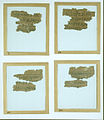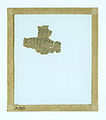|
Papyrus 62
Papyrus 62, also known as ‘‘Papyrus Osloensis’’, is a copy of the New Testament and Septuagint in Greek and Coptic known as a diglot. It is designated by the siglum 𝔓62 in the Gregory-Aland numbering of New Testament manuscripts. It is a papyrus manuscript of the Gospel of Matthew and Book of Daniel in a fragmentary condition. Using the study of comparative writing styles (palaeography), it has been assigned to the 4th century CE. DescriptionThe original manuscript would have been a codex (precursor to the modern book) made of papyrus. Unfortunately it has only survived in a fragmentary condition, containing evidence of Matthew 11:25-30, Daniel 3:51-53, and some verses from the Book of Odes.[1] The Daniel and Odes portions are labelled as Papyrus 994 in the Alfred Rahlf's numbering of Greek Septuagint manuscripts.[1] The surviving fragments evidence around 13 leaves of the original codex. The text is written in one column per page, 7 lines per column, 7-12 letters in line.[1] It has diaeresis over the letter upsilon.[1]
Matthew 11:25; 11:25; 11:25-26; 11:27; 11:27; 11:27-28; 11:28-29; 11:29-30; 11:30.
Matthew 11:25-29.[1] The manuscript contains evidence of the nomina sacra (sacred names, these being words/titles considered sacred in Christainity). The following are seen within the manuscript: θς (θεος / God), ις (Ιησους / Jesus), κε (κυριε / Lord/Master), πρ (πατηρ / Father), πηρ (πατηρ / Father), and υς (υιος / son).[1]
TextThe Greek text of the Gospel of Matthew is considered a representative of the Alexandrian text-type. Biblical scholar Kurt Aland placed it in Category II of his New Testament manuscript classification system.[2] In Matthew 11:25 it reads εκρυψας along with Codex Sinaiticus, Vaticanus, Bezae, minuscule 33, and lectionary 2211. Other manuscripts read απεκρυψας (C, L, W, Θ ƒ1, ƒ13, Byz).[3] The text of Daniel represents Theodotion's recension.[1] HistoryLeiv Amundsen dated the manuscript to the 4th century. INTF dated it to the 4th century.[2] The manuscript was found in Egypt. The text was published by Amundsen in 1945. It was examined by Maldfeld, Kurt Treu,[1] and Karl Jaroš.[4] It is cited in critical editions of the New Testament (NA26, NA27). It is currently housed at the University of Oslo Library (Inv. 1661) in Oslo.[2][5] Image gallery
See alsoReferences
Further reading
External linksWikimedia Commons has media related to Papyrus 62. |
||||||||||||||||||||||







